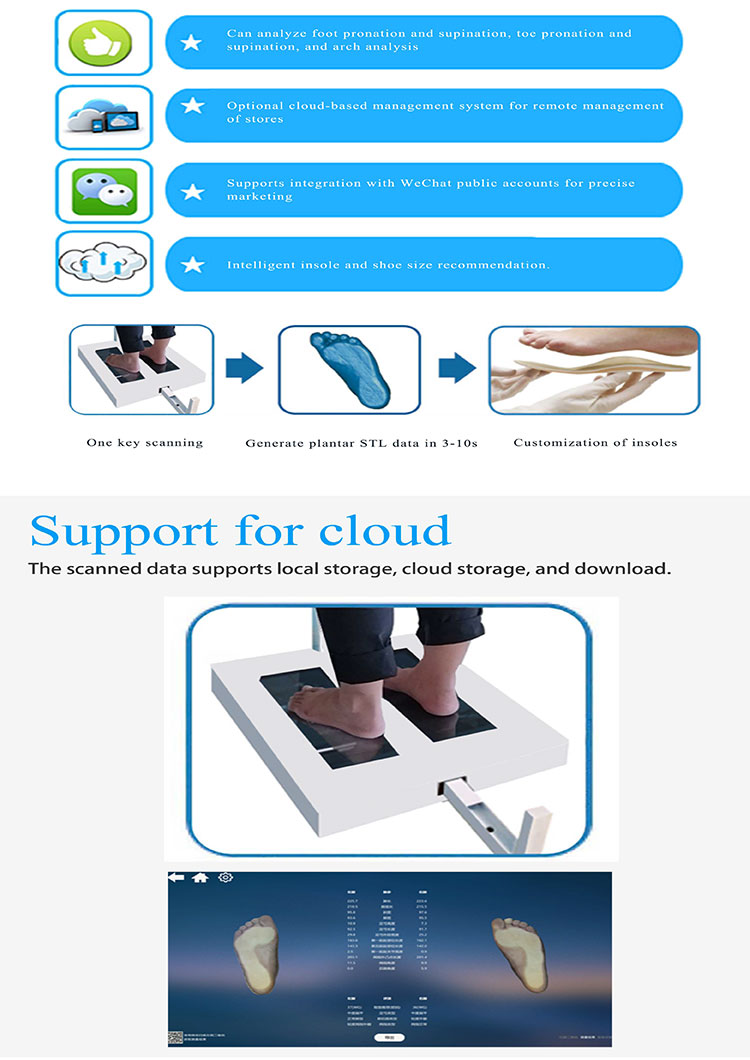With the rapid development of precision medicine and digital health management, foot 3D scanners are no longer merely static tools for clinical diagnosis, but are gradually evolving into the core data entry point for building personalized and dynamic foot health records.
Through deep integration with big data technology, this system can achieve a leap from single morphological data collection to long-term health tracking, and from individual assessment to the discovery of population-level patterns, providing comprehensive-cycle, intelligent management support for the prevention, intervention, and rehabilitation of foot-related diseases.
Multi-dimensional Data Collection: The Foundation of Building the Archive
Foot 3D scanners use non-contact optical technology to acquire high-precision 3D models of the foot surface within seconds, including dozens of anatomical parameters such as arch height, longitudinal arch angle, forefoot width, heel valgus angle, and toe alignment.
These data far exceed the scope and accuracy of traditional manual measurements. In hospital podiatry departments, rehabilitation centers, or physical examination institutions, a patient's first scan establishes a "digital baseline of the foot," serving as the initial data for the health record. Subsequent follow-up scan results can be automatically compared to generate trend charts of morphological changes, enabling dynamic monitoring.
Data Standardization and Structured Storage
To achieve big data integration, all scan data must undergo standardization. The system converts 3D point cloud data into unified formats (e.g., STL, OBJ) and extracts key indicators into a structured database.
At the same time, by combining patient basic information (age, gender, weight, occupation), medical history (diabetes, arthritis, sports injuries), gait analysis, plantar pressure distribution, and footwear habits, a comprehensive "one-person-one-file" database is formed.
Through data cleaning, deduplication, and encryption, the accuracy, completeness, and privacy security of the information are ensured.
Longitudinal Tracking and Risk Warning Model Construction
Based on long-term accumulated individual data, the system can plot curves of foot morphology evolution.
For example, in adolescent patients with flat feet, the rate of arch decline can be observed year by year; in diabetic patients, progressive foot deformities can be monitored.
Combined with machine learning algorithms, the big data platform can identify high-risk patterns, such as "annual arch decline > 2mm" or "sustained increase in pressure on the first metatarsal head," automatically triggering alerts to remind doctors to intervene early and prevent foot ulcers or joint degeneration.
Population Data Analysis and Clinical Decision Support
When individual records accumulate into a large-scale database, population-level analysis becomes possible.
For example, clustering algorithms can identify foot type distribution characteristics across different regions, occupations, or age groups (e.g., flat feet are common in Asian populations, and plantar fasciitis is prevalent among those who stand for long periods).
These insights can guide public health policy formulation, footwear design optimization, or preventive screening program promotion. Meanwhile, the system can establish a "similar case recommendation" function, automatically matching new patients' scans with similar foot types and treatment pathways in the historical database, assisting doctors in formulating personalized orthotic or rehabilitation plans.
Intelligent Services and Remote Health Management
Combined with cloud computing and mobile applications, foot health records can achieve remote access and management.
Patients can view their 3D foot models, risk scores, and rehabilitation recommendations through an app; doctors can remotely access records for teleconsultations.
In the future, portable scanning devices combined with AI analysis may enable home-based self-testing, data uploading, and automatic assessment, forming a chronic foot disease management model that links "hospitals, communities, and homes."
Promoting Precision Prevention and Personalized Intervention
Ultimately, foot health records based on big data not only serve disease treatment but also emphasize "prevention before illness."
For example, customizing pressure-relief insoles for athletes, providing gait optimization solutions to prevent falls in the elderly, or conducting occupational foot disease screenings for enterprise employees. Through data-driven approaches, a transition from "passive treatment" to "proactive health management" is achieved.

 +86-0755-86131192
+86-0755-86131192 2025-09-08
2025-09-08 Back to list
Back to list








 +86-0755-86131192
+86-0755-86131192